
 The newsletter of NASA's Radio JOVE Project
The newsletter of NASA's Radio JOVE Project"Solar and Planetary Radio Astronomy for Schools"

 The newsletter of NASA's Radio JOVE Project
The newsletter of NASA's Radio JOVE Project

Professor Thomas D. Carr passed away on April 20, 2011 at age 94. He was a Professor Emeritus of Astronomy and Physics at the University of Florida Astronomy Department.
Dr. Carr was one of the founding members of the Radio JOVE project. He contributed many ideas and designed the Radio JOVE two-dipole array.
He entered the University of Florida as an undergraduate in 1933 at age 16 and completed his Master of Science in 1940. Shortly before the start of WWII, Dr. Carr was recruited by the War Department as a Physicist and worked at the Army Proving Ground in Aberdeen, Maryland during the war. Following the end of the war, he participated in Operation Crossroads for the U.S. Navy in the tests of the A-bomb at Bikini. In 1946, after the Bikini tests, he was admitted into the physics graduate program at University of Chicago but a serious illness caused him to withdraw. After recovering, he worked for several years as a physicist at the Air Force Missile Test Center in Florida.
He was admitted into the physics graduate program at the University of Florida where he completed his Ph.D. in 1958 on the newly discovered decametric radiation from Jupiter. His degree in Physics was the first degree awarded in the subfield of Astronomy at the Univ. of Florida.
Subsequently, he joined the faculty of the Physics Department of the Univ. of Florida and continued his career and research on Jupiter’s decametric emission in collaboration with Professor Alex G. Smith. He was awarded a full professorship in 1966. After the Astronomy Dept. separated from the Physics Dept. in 1979, he served as chairman of the Astronomy Department between 1985 and 1988. In 1985 he became the Director of the University of Florida Radio Observatory until his retirement in 1995.
He was the co-initiator of the radio astronomy program at the University of Florida in 1956 and in 1959 the co-initiator of the radio astronomy program at the University of Chile. He and Prof. A.G. Smith started the observations of Jupiter radio emission in Chile in what was to become the Maipu Radio Observatory near Santiago.
In the late 1960’s Dr. Carr designed and with the help of engineers and students built the large 26.3 MHz 640 dipole array at the UF Radio Observatory for observing Jupiter’s radio emission. At that time it was the largest single frequency antenna array devoted to Jupiter observations and the only low frequency antenna with a system of Butler matrices for providing a multiple beam system. He collaborated with the Chilean radio astronomers in the design of the 528 dipole large array at 45 MHz at the Maipu Radio Observatory in Chile.
Dr. Carr's interest in planetary radio emission covered many topics. He was a co-investigator on the Planetary Radio Astronomy (PRA) instrument on the Voyager 1 and 2 spacecraft, studying the low frequency emission of Jupiter, Saturn, Uranus and Neptune.
Using ground-based radio telescopes and spacecraft data he studied several aspects of the Jovian decametric emission which included the polarization, Very Long Baseline Interferometry, long term variations of the intensity and occurrence probabilities, computation of the radio rotational period, the beaming of the decametric emission, the modeling of the modulation lanes and the micro structure of the Short (S) bursts. After his retirement in 1995 and until he passed away, he continued his investigations in the microstructure of the S bursts and its relationship with the cyclotron maser mechanism.
In recognition of his contributions to planetary radio astronomy, asteroid 96268 was named and dedicated to Dr. Carr.
He was the author or co-author of over 117 scientific papers and contributed to several books including:
Dr. Carr was a member of several professional and honor societies including the American Astronomical Society, the American Geophysical Union, and the International Astronomical Union.
He mentored, supported and served as chair on the committees of many graduate students (including the editor of the Jove Bulletin). For those who had the opportunity of being his students and colleagues, his departure will leave a void in our professional and personal lives. We all feel that we lost our leader, mentor and friend.
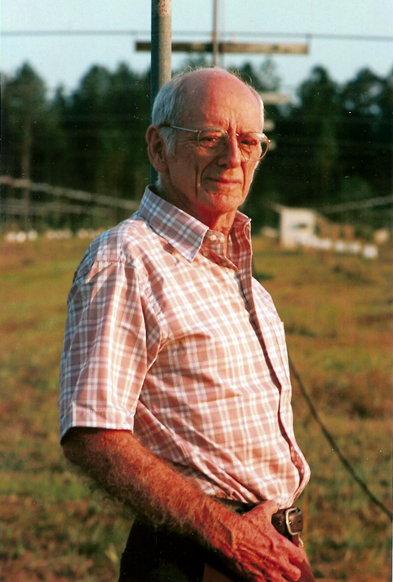
In Ethiopia space technologies are routinely being applied to assist in development, the penetration of these fields into the curriculum, however, leaves a lot to be desired. The consumption of technology alone may not bring progress, unless it is coupled with strong formal and informal education.
The Radio Jove and SID monitor program at North Carolina A&T University (NCAT), and the network of Radio Jove facilities in Ethiopia and NCAT are used to enhance undergraduate courses and provide workshops to K12 teachers and students on both sides of the Atlantic. Currently there are seven Radio Jove and seven SID monitors that are at different stages of installation in Ethiopia. The network of these facilities allows for more or less North-South data coverage in Ethiopia, as well as East West coverage when we include the facilities in the US (see Google map). This allows the students to study variations of Radio Jove and SID signals according to their location. The NCAT facility is used to troubleshoot and train African American students in the use of this equipment. Currently three NCAT students are installing the Radio Jove system, and one of the students built her own SID antenna.
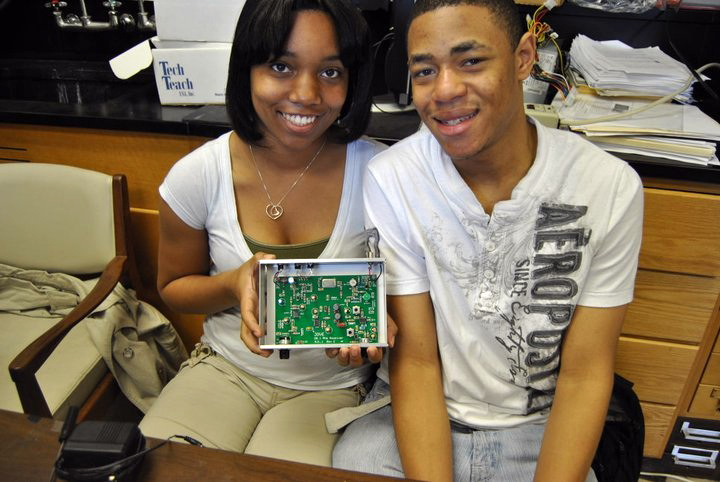
The plan for 2011 and beyond is to train a large number of teachers and students so that they acquire proficiency in astronomy and space science. For their practical experience we use online resources, remotely operated telescopes assembly and application of Radio Jove and SID Monitors. Most importantly, the teachers must be able to integrate the content and practical experience into their teaching. We plan to conduct a teacher workshop in Asela, Ethiopia and the 2nd School of Astronomy in Space Science and Technology in Education in Godar, Ethiopia, December 13-31, 2011. There are a total of six Radio Jove and seven SID monitors between the two cities. Native scientists from the USA and Ethiopia will lead these workshops. We observed during the previous workshops that schools in both cities have poorly maintained classrooms, lack teacher enhancement programs, lack books, laboratory equipment, computers, internet access and other resources. In order to address these shortages we are collaborating with Books for Africa, to ship 40,000 books, ten used computers and several soccer balls. The needs are huge and we are appealing to the NASA Radio Jove and SID community to support these donation efforts.
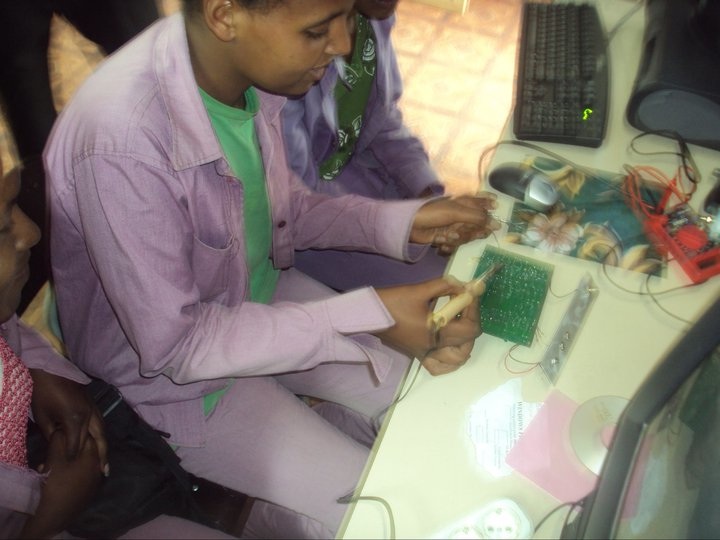
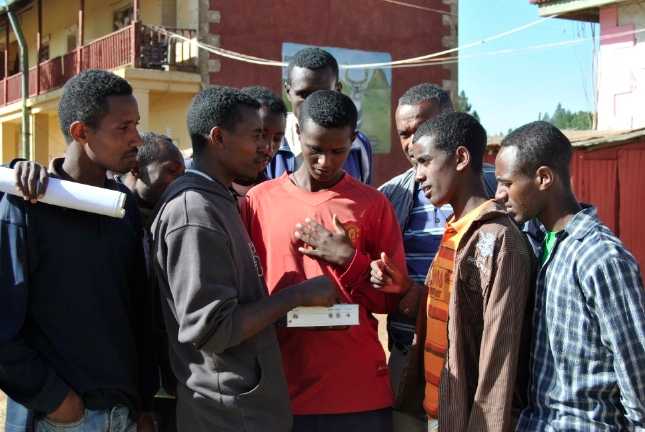
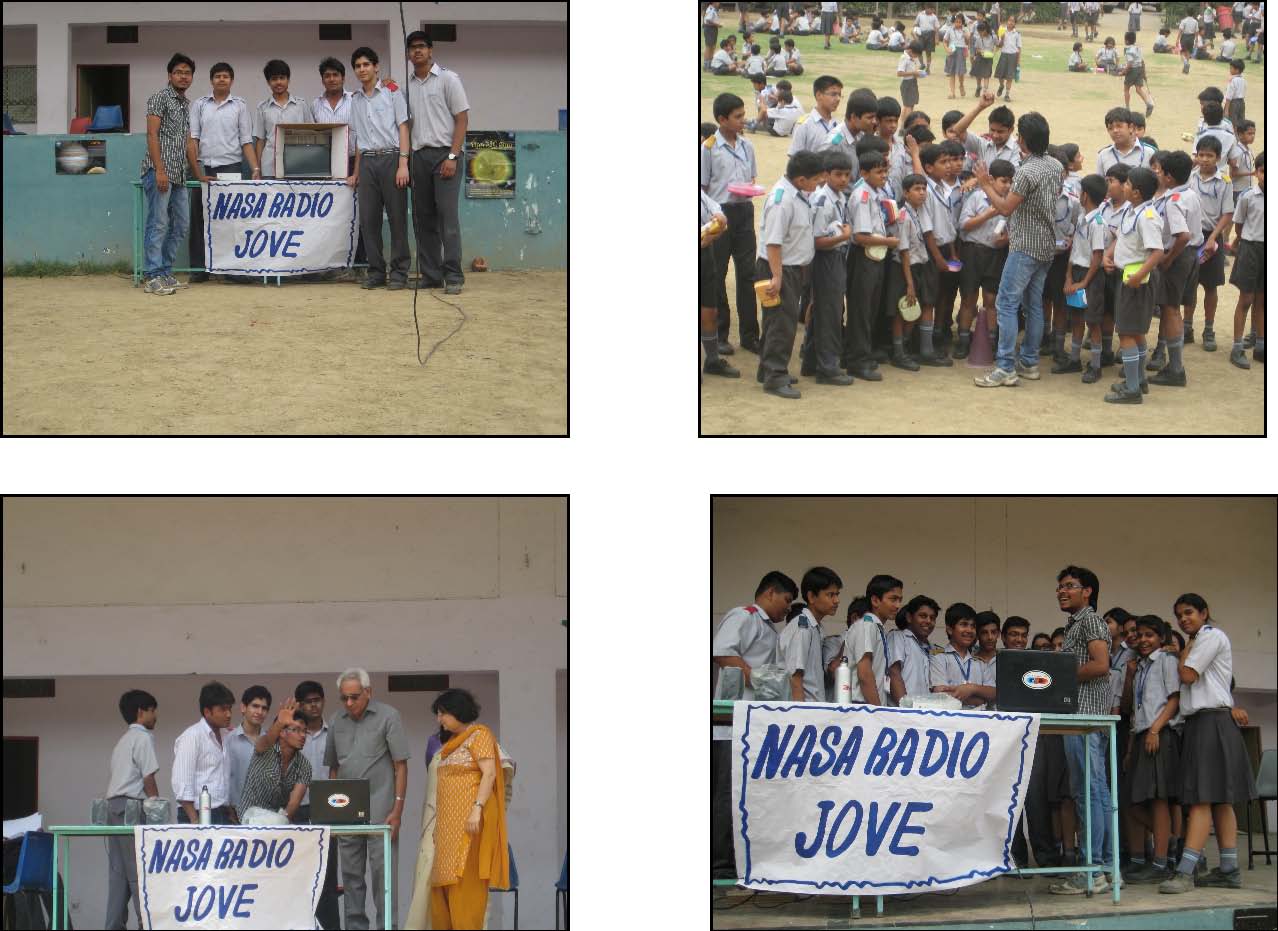
No, here we aren't talking about Aliens, or extra-terrestrial contacts but about sounds produced by heavenly bodies. Yup! You heard correctly, the sun, the planets, the galaxies around us produce radiation that we can't hear directly. This radiation from celestial activities can tell us a lot about the happenings of the outside world. We can monitor this radiation using various equipment, this is where radio astronomy comes into play.
With immense interest and enthusiasm for this relatively new field, four students of Ahlcon public School (Praful Sharma, Ayush Raina, Arjun Nair and Hardik Kumar) headed by a B. Tech student Mr. Tushar Sharma (Maharaja Surajmal Institute of Technology under GGSIPU), are participating in NASA's Radio Jove project.
Science Popularization Activity for School Students
As a part of a science popularization activity it was an immense pleasure to introduce NASA Radio Jove to school students and especially the tiny tots. An outdoor session was organized in the school grounds of Ahlcon Public School to introduce the basic concepts of NASA Radio Jove to school students. It was quite surprising to see students of standard 6thand 7thwere also immensely interested in learning about these radio bursts. It was a 5 hour activity with participation from almost 300 students from various classes.
Our volunteer effort helped reach those students who are extremely enthusiastic about the field of radio astronomy. Around 15-20 students wanted to have their own Radio Jove set up and were happy to receive our guidance. The session was accompanied by questions from students and print media personalities. Newspapers both in English and Hindi published articles on the effectiveness of learning using the Radio Jove equipment. The response of teachers on this topic was fantabulous.
Students were happy to learn that SARA facilitates radio astronomy activities. NASA's Radio Jove has turned out to be a passion for me now. I have a vision to spread this popularization and science to village students too. After all that is an ultimate aim of science.
Although our universe is vast and is nearly 14 billion light years in measurement, our knowledge and imagination is the gateway to discovering the beautiful surroundings outside of our home planet. With our ability to create advanced technology day by day, we can incorporate radio astronomy into our galactic and space-related discoveries. Radio astronomy enables users to observe deeper into our universe than ever before.

After applying for my new Radio Jove kit on NASA’s website, I thought I could use it to show its purpose to my community - I concluded my finds with a science fair project. This project stresses to my global community why and how we should use radio astronomy in our lives. Without the use of radio astronomy we have a limited view of the universe; the use of radio waves extends our view of the universe.
My science project was based upon how to filter out radio events not correlated to events in space. The radio waves are emitted by a “transmitter” which can be Jupiter, the Sun, the Galaxy, or interference, thereby producing sounds which are mapped by programs and laid out on charts. I observed radio emissions from Jupiter, called radio “storms”, which are caused by charged particles interacting with Jupiter's magnetic field; these radio emissions can be used to determine how the planet is rotating.
After explaining my project to several judges at the Synopsys Science Fair, my project won two awards. My first award was given by NASA and included a free NASA Ames Center VIP pass. My other award was given by the United States Air Force in recognition of an innovative project. The interest that mattered to me the most was not the prizes or other goodies, but the fact that I learned so much from my experiment, which included new observations of the universe that we live in today.
The Radio JOVE project teamed with the Society of Amateur Radio Astronomers (SARA) to promote radio astronomy at the Hamvention in Dayton, Ohio on May 20 - 22. At the booth were Jim Thieman and Jim Sky from Radio JOVE and Bill and Melinda Lord from SARA. Radio JOVE kits were available for purchase as well as other radio-related projects of interest.
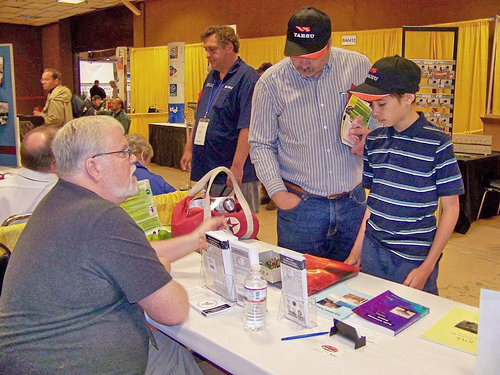
See the Hamvention web site for more information about this event.
In February Radio JOVE shared an exhibit table at the 2011 HamCation with SARA at the Central Florida Fairgrounds in Orlando, Florida. Our folks chatted with numerous folks at the event, and answered many of their questions.
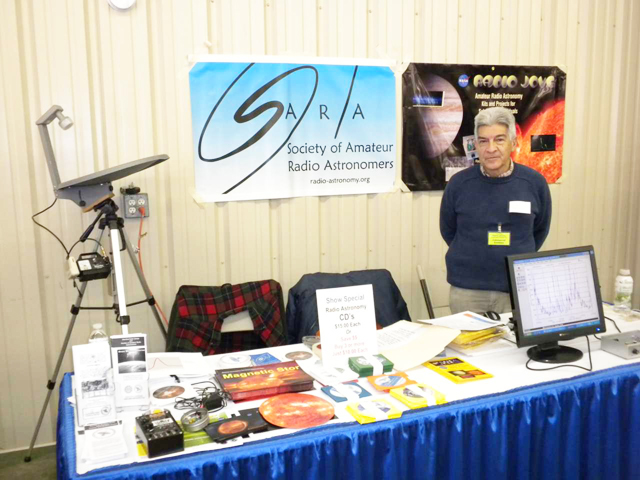
Jupiter reached inferior conjunction with the sun on April 6, 2011, putting Jupiter behind the sun and at its greatest distance from Earth. At conjunction, Jupiter and the Sun rise at the same time. As Earth and Jupiter continue to move eastward in their orbits, Earth “catches up” to Jupiter because of a faster orbital speed; therefore, Jupiter will move away from its hiding place behind the sun – rising before the sun in the predawn hours.With each passing month the separation between Jupiter and the sun will increase until we reach opposition on October 29, 2011, when Jupiter rises at sunset and sets at sunrise. At opposition Jupiter transit occurs at midnight.
By early June 2011 Jupiter will rise about 3 hours before the sun giving early risers an opportunity to begin Jupiter observations. Ionospheric conditions may allow reception till a few hours after sunrise. As the season progresses Jupiter will transit earlier each night – eventually slipping into evening hours in the winter of 2012.
An old rule of thumb used to be that you could only hear Jupiter from a few hours after sunset till sunrise – but this was in the days of high solar activity, which had a great effect on the transparency of the earth’s ionosphere. With the extremely quiet sun during solar minimum it was possible to hear Jupiter during the night and for 2 to 3 hours after sunrise or before sunset. As the sun is finally becoming more active, daylight observing of Jupiter will become more difficult.
The very approximate dates of this upcoming observing season are from June 2011 till early March 2012, with conjunction occurring once again on May 13, 2012. A cautionary note to summertime observers – it’s a good idea to disconnect your Jove antenna when not in use – lightning is not your friend.
For the past several years many factors have conspired to make for difficult listening conditions for Jupiter – particularly for observers in the northern hemisphere.
1. Jupiter has been at southern declinations meaning that it has been necessary to raise our antennas and steer our northern hemisphere antenna beams toward the southern horizon. Even at transit, Jupiter was relatively low in the sky for high northern latitude observers. In January of 2010 Jupiter was at -13 deg declination. Jupiter is now at +12 degrees and will continue its northern migration, peaking at +23 degrees in 2013.
2. When Jupiter was at southern declinations it was coincidentally close to the galactic center – which is about twice as noisy as many other directions in space. So we have been listening for Jupiter against a noisy galactic background, which has made the ratio of Jupiter to background weaker. As Jupiter heads north and pulls away from the galactic center we should see stronger Jupiter signals compared to the galactic background noise.
3. Some of the best observing times are around opposition – that is when Jupiter transits near local midnight. In 2008 this occurred on July 9, in the middle of the summer – and hence in the middle of lightning season. Opposition date moves about a month forward each year and in 2011 it occurs near the end of October. This will put the best observing times in fall rather than summer – and listening conditions should be much better.
4. Jovian decameter wavelength radio signals appear to be emitted in a rather narrow beam and the Jovicentric declination of the earth (De) is an important factor in determining if we are “in the beam”. Over the years the earth moves north and south in the Jovian sky by about 6 degrees. When we are at positive declinations Jupiter signals are more predictable and often stronger. The earth was at negative Jovicentric declinations from 2003 to 2009 and is now approaching the maximum positive declination value of 3 degrees. Many observers noted that Jupiter radio noise storms received late in 2010 were stronger than they had heard in years, so the positive values of De seem to be working their magic once again.
So put it all together – northern declination, quieter galactic background noise, better listening conditions, more predictable and probably stronger signals – sounds good to me.
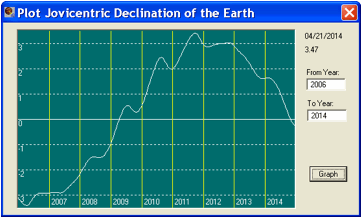
For several years Jupiter has been at southern declinations and northern hemisphere Jove observers have had to raise their antennas and install a phasing cable to swing the antenna beam into southern skies.
Jupiter is now coming north once again which is good news for northern hemisphere observers – Jupiter will transit higher in the sky for the next several years. For low to mid northern latitudes this means that you can lower your antenna back to 3 meters and remove the phasing cable connected in the line from the south dipole to the power combiner.
We are currently working to update the antenna manual which will give more details on who should make this change and when. In the meantime you can use the antenna beaming pattern display in Radio Jupiter Pro to determine the optimum configuration for your location. Figure 1 below shows the beaming pattern for a dual dipole at 15 feet located in northern Florida with the phasing cable installed. This pattern was optimum when Jupiter was further south but now you can see even at transit the Jupiter track in the sky just grazes the northern edge of the antenna beam.

Compare this with the pattern of a 10 ft high dual dipole connected in-phase as seen in Figure 2. Jupiter stays within the 3dB boundary of the antenna beam for almost 3 hours.

And finally we see the effect in Figure 3 of orienting the antenna wires so that they run north-south. Notice that the beam now is wider in the east-west direction than the previous configuration – allowing a bit longer time with Jupiter in the beam. If you wish to leave your antenna in the E-W direction, that’s okay. No harm is done; for optimum performance in this configuration, check the height and phasing cables and adjust as necessary.
As Jupiter moves to higher northern declinations its track across the sky will favor the 10 ft high configuration with wires running north-south. This is true for low and mid northern latitudes. Those of you that dwell further north may still need to have your antenna up 15 or even 20 feet with a southern phasing cable. It’s a good idea to run some simulations for your location – even running the date forward so that you can plan the optimum configuration for the next few years.
Of course our southern hemisphere friends have enjoyed Jupiter for the past several years – high in their sky at transit. Now they will sadly watch Jupiter move north. They should use this same Radio Jupiter Pro Skymap utility to determine when to raise their antennas and install a phasing cable in their north dipole line.

The JOVE Bulletin is published twice a year. It is a free service of the Radio JOVE Project. We hope you will find it of value. Back issues are available on the Radio JOVE Project Web site, http://radiojove.gsfc.nasa.gov/
For assistance or information send inquiries to:
or
